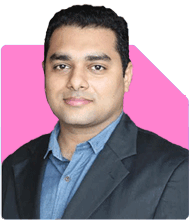Ramalingam Kalirajan |10870 Answers |Ask -Follow
Mutual Funds, Financial Planning Expert - Answered on May 29, 2024
He has an MBA in finance from the University of Madras and is a certified financial planner.
He is the director and chief financial planner at Holistic Investment, a Chennai-based firm that offers financial planning and wealth management advice.... more

I am investing SIP Rs41000 per month.I am not having a proper guidance on this investments.Please go thru & give your suggestion to improve on this investments Investments: GFGPG - HDFC Large and Mid Cap Fund - Regular Plan - Growth EDWRG - ICICI Prudential Balanced Advantage Fund - Growth 3349 - ICICI Prudential Bharat Consumption Fund Growth EDWRG - ICICI Prudential Balanced Advantage Fund - Growth 1191 - ICICI Prudential Bluechip Fund - Growth 3251 - ICICI Prudential India Opportunities Fund Growth 121 - ICICI Prudential Multicap Fund - Growth 71 - ICICI Prudential Technology Fund - Growth 3443 - ICICI Prudential Flexicap Fund Growth 8019 - ICICI Prudential Technology Fund - Direct Plan - Growth 8034 - ICICI Prudential Smallcap Fund - Direct Plan - Growth 1191 - ICICI Prudential Bluechip Fund - Growth SCAG - NIPPON INDIA SMALL CAP FUND - DIRECT GROWTH PLAN GROWTH OPTION OFDG - Quant Mid Cap Fund - Growth INF966L01887 51010091 075/0 DIRECT 103.033 139.1977 14,000.00 14,341.96 0 .5 0 DIFGZ - Tata Digital India Fund Direct Plan Growth
Current Portfolio Analysis:
Number of Funds: Having 11 funds might be too many to manage effectively. It can be difficult to track performance and make adjustments.
Overlap: There might be overlap between some funds in terms of the stocks they invest in. This reduces diversification benefits.
Investment Strategy: Your portfolio has a mix of fund categories (Large & Mid Cap, Balanced Advantage, Sectoral, etc.). It's good, but we can improve it for your goals.
Here's why I can't give specific advice on your funds:
Performance: Past performance isn't a guarantee of future results. What did well yesterday might not do well tomorrow.
Your Goals: I don't know your investment goals (retirement, child's education, etc.) These influence the best investment choices.
Here are some suggestions to improve your portfolio:
Reduce the number of funds: Aim for 4-5 well-diversified funds across different market capitalizations (Large, Mid, and Small Cap).
Consider Asset Allocation: Decide on a strategic asset allocation based on your risk tolerance and goals. This helps you pick the right mix of asset classes (equity, debt).
Actively Managed Funds: Actively managed funds, where experienced professionals make investment decisions, can potentially outperform the market. Consider consulting a Certified Financial Planner (CFP) to help you choose these funds.
Benefits of a Regular Plan with a CFP:
Guidance: A CFP can analyze your financial situation and recommend a suitable investment strategy.
Portfolio Monitoring: They can help you track your investments and make adjustments as needed.
Goal Planning: They can help you set realistic financial goals and choose investments to achieve them.
Regular plans with a CFP might have slightly higher fees than direct plans, but the guidance can be valuable, especially for new investors.
Here are some additional thoughts:
Review Regularly: Meet with your CFP periodically to review your portfolio and adjust it as your life and goals evolve.
Stay Invested: Don't panic and redeem your investments during market downturns. A long-term view is important for building wealth.
By streamlining your portfolio, seeking professional help, and staying invested, you can increase your chances of achieving your financial goals.
Best Regards,
K. Ramalingam, MBA, CFP,
Chief Financial Planner,
www.holisticinvestment.in
You may like to see similar questions and answers below
Nikunj Saraf | Answer |Ask -Follow
Mutual Funds Expert - Answered on Mar 29, 2023
Nikunj Saraf | Answer |Ask -Follow
Mutual Funds Expert - Answered on May 22, 2023
Ramalingam Kalirajan |10870 Answers |Ask -Follow
Mutual Funds, Financial Planning Expert - Answered on Apr 23, 2024
Ramalingam Kalirajan |10870 Answers |Ask -Follow
Mutual Funds, Financial Planning Expert - Answered on May 16, 2024
Naveenn Kummar |233 Answers |Ask -Follow
Financial Planner, MF, Insurance Expert - Answered on Sep 09, 2025
Dr Dipankar Dutta |1837 Answers |Ask -Follow
Tech Careers and Skill Development Expert - Answered on Dec 05, 2025
Dr Shyam Jamalabad |108 Answers |Ask -Follow
Dentist - Answered on Dec 05, 2025
Dr Shyam Jamalabad |108 Answers |Ask -Follow
Dentist - Answered on Dec 05, 2025
Dr Shyam Jamalabad |108 Answers |Ask -Follow
Dentist - Answered on Dec 05, 2025
Dr Dipankar Dutta |1837 Answers |Ask -Follow
Tech Careers and Skill Development Expert - Answered on Dec 05, 2025
Ulhas Joshi |280 Answers |Ask -Follow
Mutual Fund Expert - Answered on Dec 05, 2025
Dr Dipankar Dutta |1837 Answers |Ask -Follow
Tech Careers and Skill Development Expert - Answered on Dec 04, 2025
Ravi Mittal |676 Answers |Ask -Follow
Dating, Relationships Expert - Answered on Dec 04, 2025
Anu Krishna |1745 Answers |Ask -Follow
Relationships Expert, Mind Coach - Answered on Dec 04, 2025
Anu Krishna |1745 Answers |Ask -Follow
Relationships Expert, Mind Coach - Answered on Dec 04, 2025


























